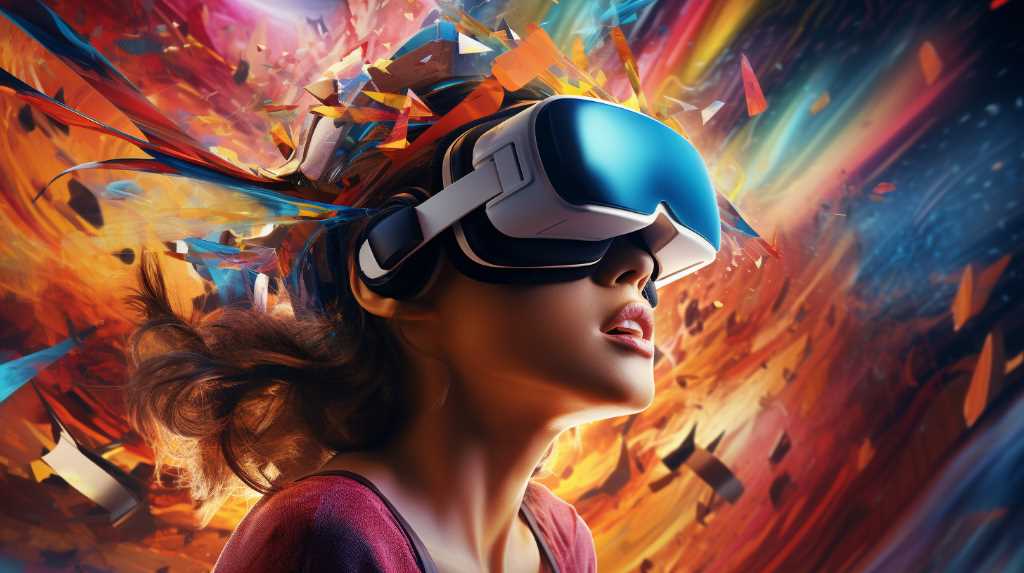Are you ready to step into a world where art knows no boundaries? We will explore how VR is revolutionizing creative expression. Immerse yourself in virtual art galleries, where the lines between reality and imagination blur.
Discover how artists are pushing the limits of their vision through 3D art in VR environments. Prepare to be captivated by the unique experiences offered by VR art installations. Join us as we delve into the impact of VR on artists and the accessibility it brings to artistic expression.
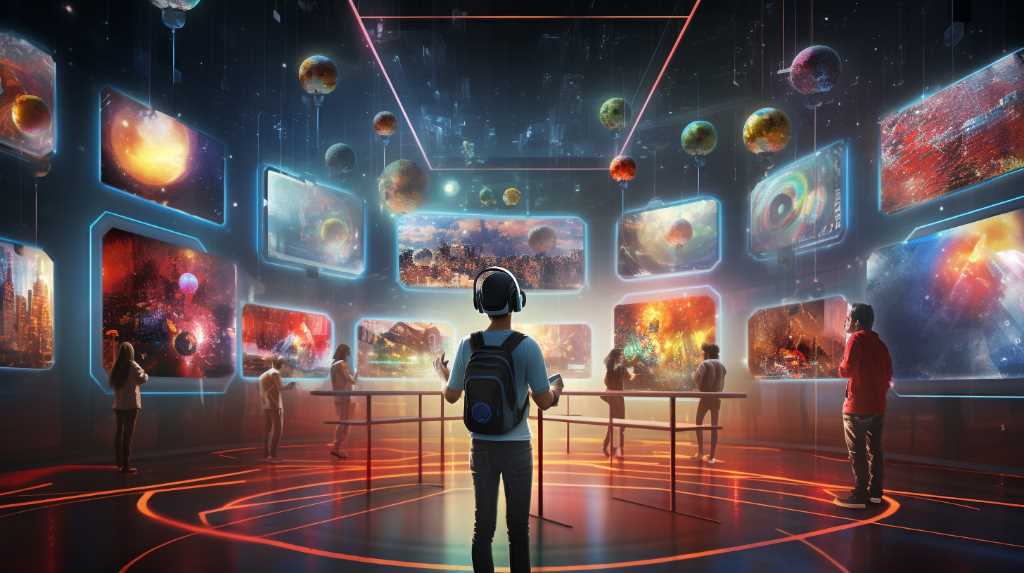 You can explore countless masterpieces from around the world in VR art galleries. Step into a virtual realm where art comes to life, and immerse yourself in a whole new way of experiencing creativity. With virtual reality technology, you have the opportunity to wander through digital galleries and view stunning artworks from the comfort of your own home.
In these VR art galleries, you can marvel at the brushstrokes of Van Gogh's 'Starry Night' or get lost in the vibrant colors of Monet's 'Water Lilies.' The level of detail and realism in these virtual spaces is truly astounding. As you move through the gallery, you can get up close to each painting, examining the fine details that may be missed in a traditional museum setting.
One of the most exciting aspects of VR art galleries is the ability to visit exhibitions from all over the world. No longer limited by geography, you can explore the Louvre in Paris, the Tate Modern in London, or the Museum of Modern Art in New York City, all from the comfort of your living room. This opens up a whole new world of possibilities for art enthusiasts and allows for a more inclusive and accessible art experience.
VR art galleries aren't just a substitute for physical museums; they offer a unique and immersive way to engage with art. So put on your VR headset and step into a virtual world where creativity knows no bounds.
You can explore countless masterpieces from around the world in VR art galleries. Step into a virtual realm where art comes to life, and immerse yourself in a whole new way of experiencing creativity. With virtual reality technology, you have the opportunity to wander through digital galleries and view stunning artworks from the comfort of your own home.
In these VR art galleries, you can marvel at the brushstrokes of Van Gogh's 'Starry Night' or get lost in the vibrant colors of Monet's 'Water Lilies.' The level of detail and realism in these virtual spaces is truly astounding. As you move through the gallery, you can get up close to each painting, examining the fine details that may be missed in a traditional museum setting.
One of the most exciting aspects of VR art galleries is the ability to visit exhibitions from all over the world. No longer limited by geography, you can explore the Louvre in Paris, the Tate Modern in London, or the Museum of Modern Art in New York City, all from the comfort of your living room. This opens up a whole new world of possibilities for art enthusiasts and allows for a more inclusive and accessible art experience.
VR art galleries aren't just a substitute for physical museums; they offer a unique and immersive way to engage with art. So put on your VR headset and step into a virtual world where creativity knows no bounds.
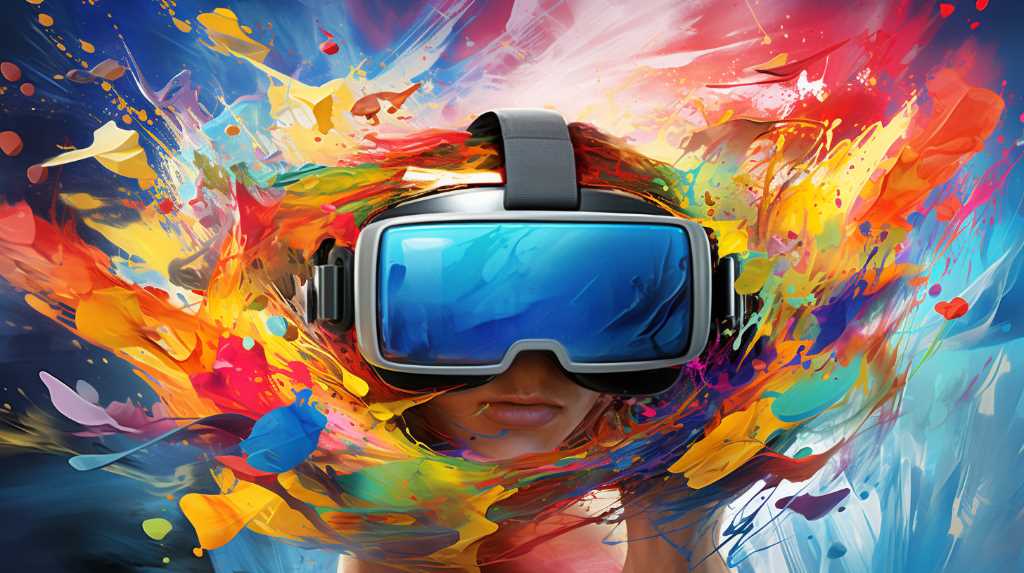 Step into the virtual realm and witness the limitless creative expression that VR brings to the forefront. In this ever-evolving technological landscape, VR has become a powerful tool that allows artists to push the boundaries of traditional artistic mediums. With VR, you can immerse yourself in a world where art isn't confined to canvas or sculpture but rather transcends into a multidimensional experience.
Imagine stepping into a virtual art gallery where you can interact with paintings, sculptures, and installations, all created using VR technology. As you move through the virtual space, you can touch, feel, and even manipulate the art around you. The possibilities are endless. Artists are no longer limited by physical constraints but can explore new dimensions, experiment with unconventional materials, and challenge the very concept of what art can be.
VR also allows for collaborative artistic ventures on a global scale. Artists from different parts of the world can come together in a virtual space and create art in real-time, breaking down barriers of distance and time. This level of connectivity opens up a whole new realm of possibilities for collaboration, inspiration, and cross-cultural dialogue.
Step into the virtual realm and witness the limitless creative expression that VR brings to the forefront. In this ever-evolving technological landscape, VR has become a powerful tool that allows artists to push the boundaries of traditional artistic mediums. With VR, you can immerse yourself in a world where art isn't confined to canvas or sculpture but rather transcends into a multidimensional experience.
Imagine stepping into a virtual art gallery where you can interact with paintings, sculptures, and installations, all created using VR technology. As you move through the virtual space, you can touch, feel, and even manipulate the art around you. The possibilities are endless. Artists are no longer limited by physical constraints but can explore new dimensions, experiment with unconventional materials, and challenge the very concept of what art can be.
VR also allows for collaborative artistic ventures on a global scale. Artists from different parts of the world can come together in a virtual space and create art in real-time, breaking down barriers of distance and time. This level of connectivity opens up a whole new realm of possibilities for collaboration, inspiration, and cross-cultural dialogue.
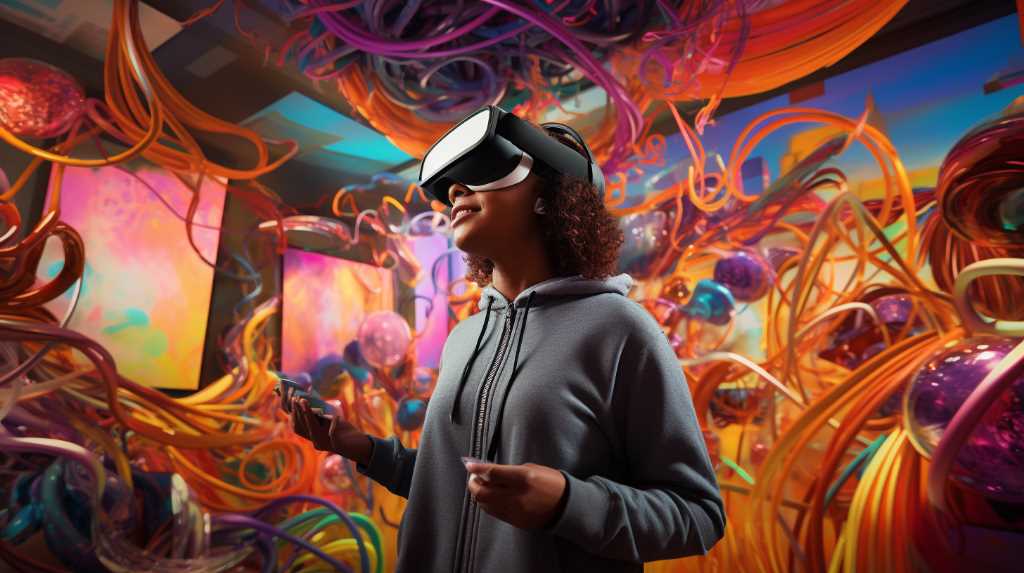 Step into the virtual realm and let your artistic vision come alive in breathtaking 3D. With immersive 3D canvases, you can break free from the constraints of traditional art forms and explore new dimensions of creation.
Embrace the endless possibilities and push the boundaries of what art can be in VR environments.
Step into the virtual realm and let your artistic vision come alive in breathtaking 3D. With immersive 3D canvases, you can break free from the constraints of traditional art forms and explore new dimensions of creation.
Embrace the endless possibilities and push the boundaries of what art can be in VR environments.
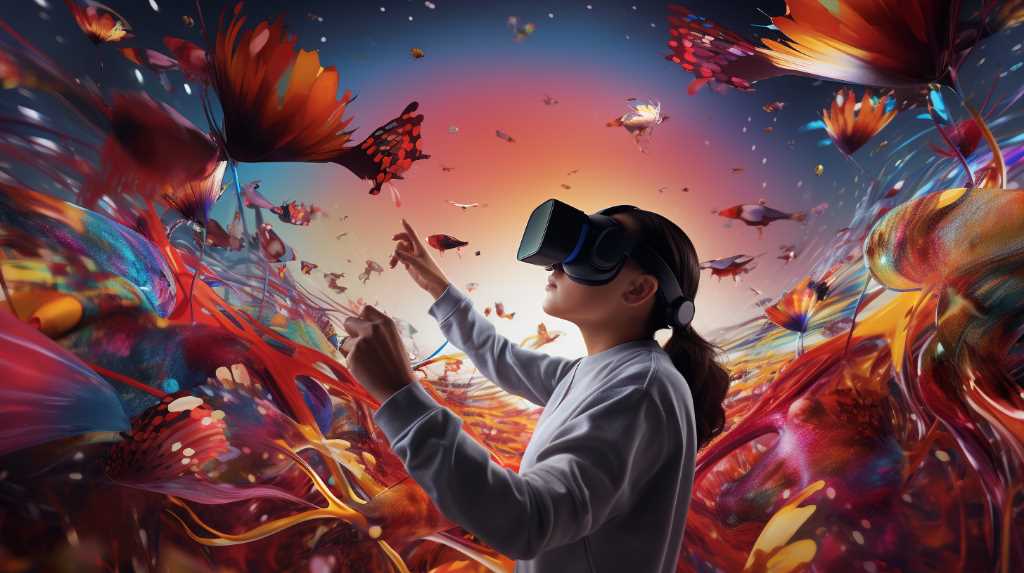 Immerse yourself in the breathtaking world of VR art installations, where reality blends seamlessly with imagination. Step into a realm where you become an active participant, exploring captivating experiences that push the boundaries of traditional art forms. VR art installations offer a unique opportunity to engage with art in a whole new way.
As you enter a virtual gallery, you're immediately transported to another dimension. With each step, you encounter vibrant colors, intricate designs, and surreal landscapes. The art comes to life around you, inviting you to touch, manipulate, and interact with it. With a simple gesture, you can change the lighting, alter the perspective, or even add your own elements to the artwork.
The beauty of VR art installations lies in the freedom they provide. You're no longer bound by the limitations of physical space or materials. Instead, you can explore endless possibilities and experiment with different artistic techniques. From painting in 3D space to sculpting with virtual clay, the possibilities are as infinite as your imagination.
Beyond the immersive experience, VR art installations also challenge our perception of reality. By blurring the lines between what's real and what's virtual, these installations prompt us to question our understanding of art and its role in society. They spark conversations about the nature of creativity, the boundaries of artistic expression, and the power of technology to reshape the art world.
Immerse yourself in the breathtaking world of VR art installations, where reality blends seamlessly with imagination. Step into a realm where you become an active participant, exploring captivating experiences that push the boundaries of traditional art forms. VR art installations offer a unique opportunity to engage with art in a whole new way.
As you enter a virtual gallery, you're immediately transported to another dimension. With each step, you encounter vibrant colors, intricate designs, and surreal landscapes. The art comes to life around you, inviting you to touch, manipulate, and interact with it. With a simple gesture, you can change the lighting, alter the perspective, or even add your own elements to the artwork.
The beauty of VR art installations lies in the freedom they provide. You're no longer bound by the limitations of physical space or materials. Instead, you can explore endless possibilities and experiment with different artistic techniques. From painting in 3D space to sculpting with virtual clay, the possibilities are as infinite as your imagination.
Beyond the immersive experience, VR art installations also challenge our perception of reality. By blurring the lines between what's real and what's virtual, these installations prompt us to question our understanding of art and its role in society. They spark conversations about the nature of creativity, the boundaries of artistic expression, and the power of technology to reshape the art world.
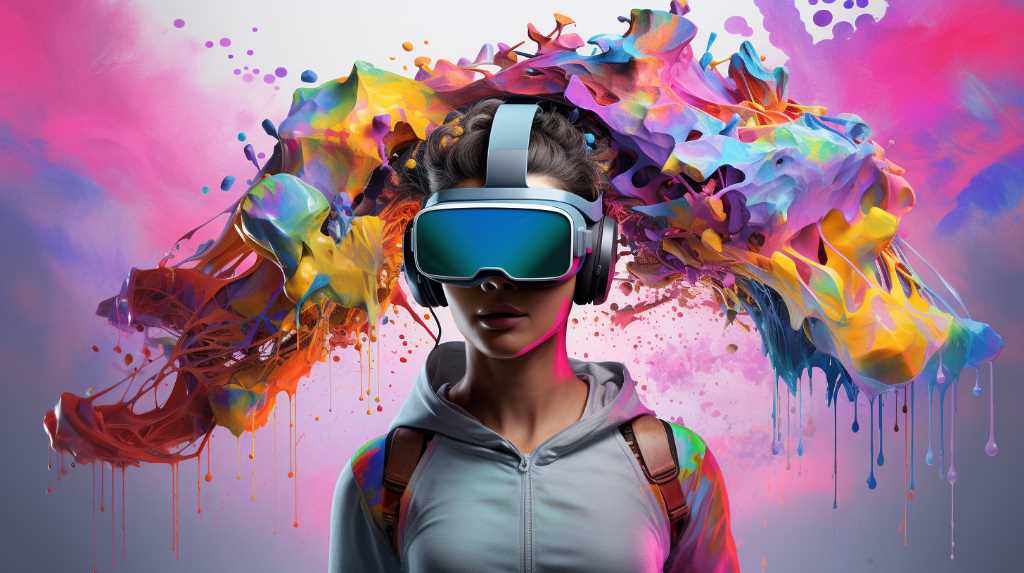 Step into the virtual realm of artistic exploration and witness firsthand how VR is revolutionizing the way artists create and engage with their work.
Step into the virtual realm of artistic exploration and witness firsthand how VR is revolutionizing the way artists create and engage with their work.
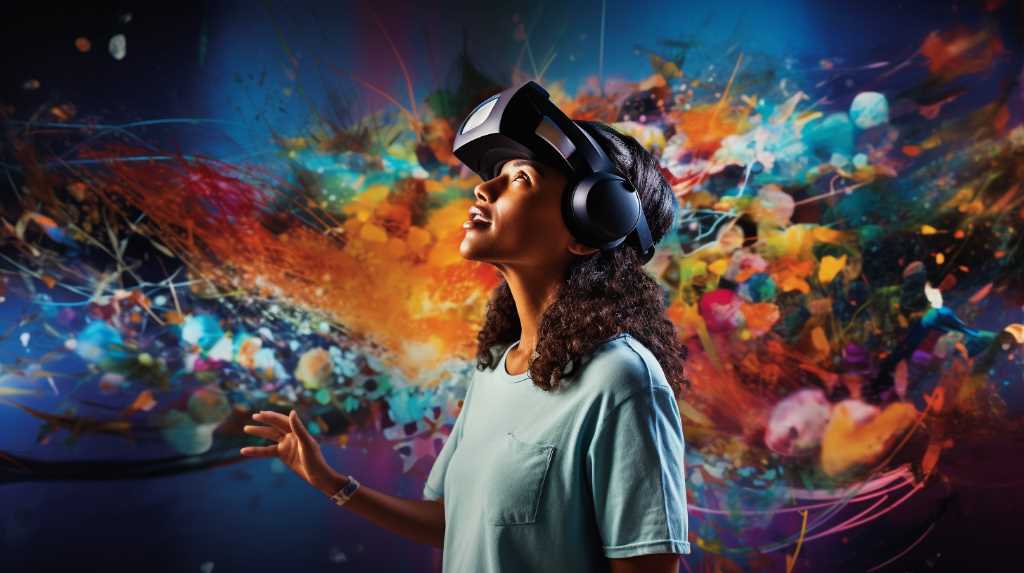 Witness the shift in perception as VR seamlessly transports you into a world where art experiences are transformed through immersive virtual reality technology. With VR, you no longer passively observe art; instead, you actively engage with it, becoming a part of the artwork itself. Imagine stepping into a painting by Van Gogh, walking through the vibrant fields of sunflowers or feeling the brushstrokes of his iconic Starry Night. Through VR, artists can push the boundaries of their creativity, bending reality and challenging traditional artistic mediums.
VR has the power to revolutionize how we perceive and interact with art. It allows us to explore new dimensions and perspectives, enabling a deeper connection to the artwork. As you put on the VR headset, you're transported to a virtual gallery, where you can wander through exhibitions, interact with sculptures, and even collaborate with other virtual visitors. The possibilities are endless.
Moreover, VR opens up new avenues for artists to experiment and innovate. They can create immersive installations, where viewers can physically interact with the artwork, blurring the lines between the real and the virtual. Artists can also collaborate with programmers and designers to create intricate virtual worlds that push the boundaries of imagination.
Witness the shift in perception as VR seamlessly transports you into a world where art experiences are transformed through immersive virtual reality technology. With VR, you no longer passively observe art; instead, you actively engage with it, becoming a part of the artwork itself. Imagine stepping into a painting by Van Gogh, walking through the vibrant fields of sunflowers or feeling the brushstrokes of his iconic Starry Night. Through VR, artists can push the boundaries of their creativity, bending reality and challenging traditional artistic mediums.
VR has the power to revolutionize how we perceive and interact with art. It allows us to explore new dimensions and perspectives, enabling a deeper connection to the artwork. As you put on the VR headset, you're transported to a virtual gallery, where you can wander through exhibitions, interact with sculptures, and even collaborate with other virtual visitors. The possibilities are endless.
Moreover, VR opens up new avenues for artists to experiment and innovate. They can create immersive installations, where viewers can physically interact with the artwork, blurring the lines between the real and the virtual. Artists can also collaborate with programmers and designers to create intricate virtual worlds that push the boundaries of imagination.
 As a participant, you can now actively engage with art and break barriers through VR, expanding the accessibility to artistic expression. Virtual Reality has revolutionized the way we experience and interact with art, making it more immersive and inclusive than ever before.
Here's how VR is breaking barriers and making art more accessible:
As a participant, you can now actively engage with art and break barriers through VR, expanding the accessibility to artistic expression. Virtual Reality has revolutionized the way we experience and interact with art, making it more immersive and inclusive than ever before.
Here's how VR is breaking barriers and making art more accessible:
 Immerse yourself in the intersection of virtual and physical art, experiencing a dynamic fusion of creative realities. The current discussion topic revolves around the exciting possibilities that arise when virtual reality (VR) and traditional art forms collide.
In recent years, VR has emerged as a powerful tool for artists to break free from the constraints of physical space and explore new dimensions of creativity.
By blending virtual and physical elements, artists can create immersive experiences that transcend the boundaries of traditional art mediums. Imagine stepping into a virtual world where paintings come to life before your eyes, sculptures morph and transform with your touch, and music resonates deep within your soul. This fusion of VR and physical art offers a unique opportunity for artists to engage their audience on a whole new level.
Furthermore, the intersection of virtual and physical art opens up new avenues for collaboration and experimentation. Artists can now collaborate across different disciplines, combining their expertise to create truly multidimensional works of art. The possibilities are endless, from interactive VR installations that challenge our perceptions, to virtual galleries that allow us to explore art from the comfort of our own homes.
As technology continues to advance, the line between virtual and physical art will continue to blur. The intersection of these two realms holds immense potential for artistic expression, providing artists and audiences alike with a transformative and captivating experience.
Immerse yourself in the intersection of virtual and physical art, experiencing a dynamic fusion of creative realities. The current discussion topic revolves around the exciting possibilities that arise when virtual reality (VR) and traditional art forms collide.
In recent years, VR has emerged as a powerful tool for artists to break free from the constraints of physical space and explore new dimensions of creativity.
By blending virtual and physical elements, artists can create immersive experiences that transcend the boundaries of traditional art mediums. Imagine stepping into a virtual world where paintings come to life before your eyes, sculptures morph and transform with your touch, and music resonates deep within your soul. This fusion of VR and physical art offers a unique opportunity for artists to engage their audience on a whole new level.
Furthermore, the intersection of virtual and physical art opens up new avenues for collaboration and experimentation. Artists can now collaborate across different disciplines, combining their expertise to create truly multidimensional works of art. The possibilities are endless, from interactive VR installations that challenge our perceptions, to virtual galleries that allow us to explore art from the comfort of our own homes.
As technology continues to advance, the line between virtual and physical art will continue to blur. The intersection of these two realms holds immense potential for artistic expression, providing artists and audiences alike with a transformative and captivating experience.
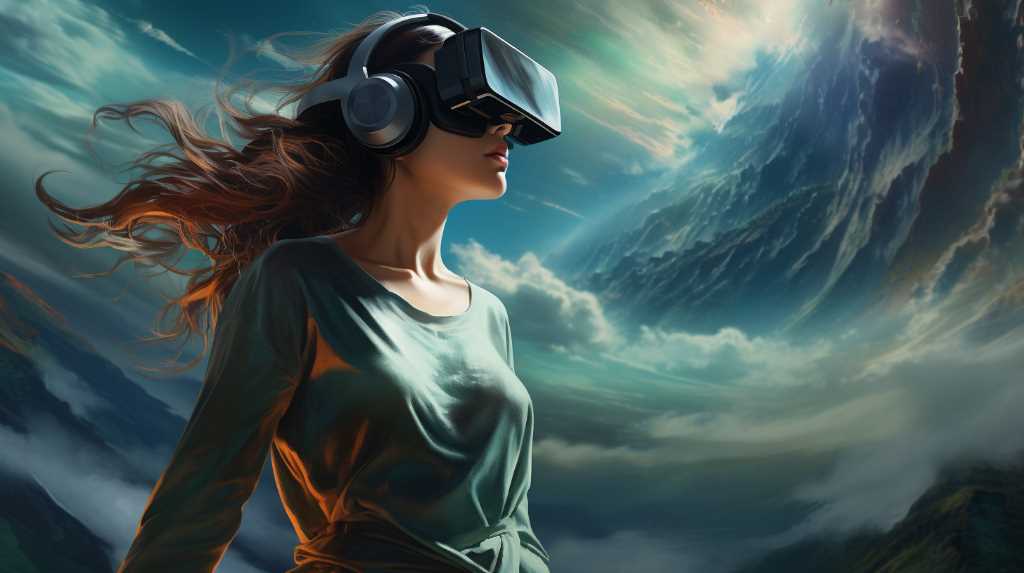 Feel the immersive power of virtual reality as it transports you to a world where art becomes a visceral experience, evoking emotions like never before. With the advancement of technology, virtual reality has opened up new possibilities for artistic expression, creating a medium that goes beyond traditional forms of art. Here's how VR is redefining the way we experience and communicate emotions through art:
Feel the immersive power of virtual reality as it transports you to a world where art becomes a visceral experience, evoking emotions like never before. With the advancement of technology, virtual reality has opened up new possibilities for artistic expression, creating a medium that goes beyond traditional forms of art. Here's how VR is redefining the way we experience and communicate emotions through art:
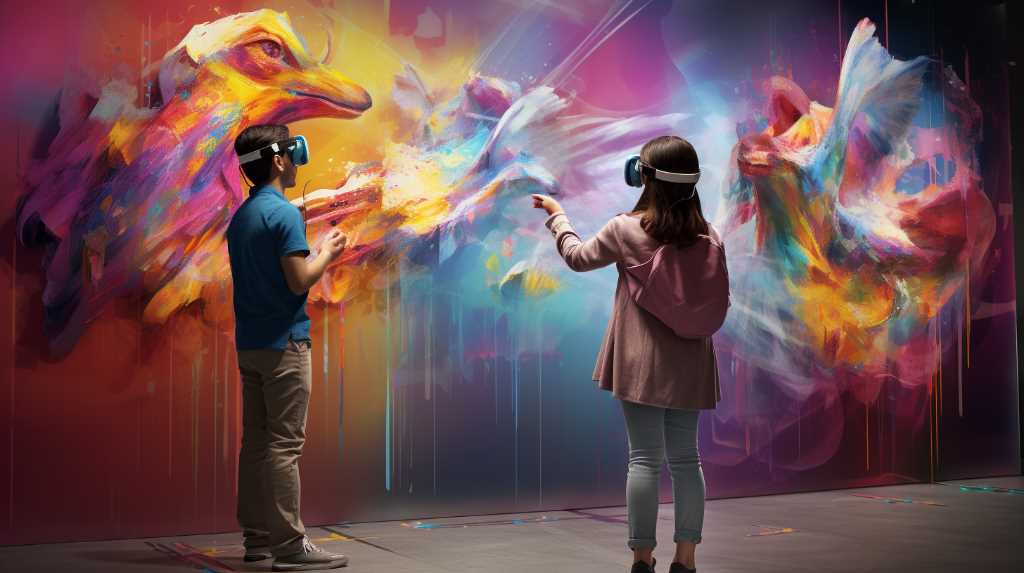 Immerse yourself in a new world with VR technology, redefining how audiences engage with art. Experience interactive storytelling like never before, where you become an active participant in the narrative.
VR enhances viewer participation, blurring the lines between artist and audience, and opening up endless possibilities for creative expression.
Immerse yourself in a new world with VR technology, redefining how audiences engage with art. Experience interactive storytelling like never before, where you become an active participant in the narrative.
VR enhances viewer participation, blurring the lines between artist and audience, and opening up endless possibilities for creative expression.
Key Takeaways
- VR art galleries offer a unique and immersive art experience, allowing for exploration of digital galleries from home and close examination of artworks.
- VR technology allows artists to push the boundaries of traditional artistic mediums, facilitating global collaboration, experimentation, and innovation.
- VR seamlessly transports participants into immersive virtual worlds, transforming art experiences and expanding accessibility to artistic expression.
- VR allows for sensory immersion, spatial storytelling, and interactive experiences, creating a new world of immersive art and enhancing viewer participation.
The Immersive World of VR Art Galleries
 You can explore countless masterpieces from around the world in VR art galleries. Step into a virtual realm where art comes to life, and immerse yourself in a whole new way of experiencing creativity. With virtual reality technology, you have the opportunity to wander through digital galleries and view stunning artworks from the comfort of your own home.
In these VR art galleries, you can marvel at the brushstrokes of Van Gogh's 'Starry Night' or get lost in the vibrant colors of Monet's 'Water Lilies.' The level of detail and realism in these virtual spaces is truly astounding. As you move through the gallery, you can get up close to each painting, examining the fine details that may be missed in a traditional museum setting.
One of the most exciting aspects of VR art galleries is the ability to visit exhibitions from all over the world. No longer limited by geography, you can explore the Louvre in Paris, the Tate Modern in London, or the Museum of Modern Art in New York City, all from the comfort of your living room. This opens up a whole new world of possibilities for art enthusiasts and allows for a more inclusive and accessible art experience.
VR art galleries aren't just a substitute for physical museums; they offer a unique and immersive way to engage with art. So put on your VR headset and step into a virtual world where creativity knows no bounds.
You can explore countless masterpieces from around the world in VR art galleries. Step into a virtual realm where art comes to life, and immerse yourself in a whole new way of experiencing creativity. With virtual reality technology, you have the opportunity to wander through digital galleries and view stunning artworks from the comfort of your own home.
In these VR art galleries, you can marvel at the brushstrokes of Van Gogh's 'Starry Night' or get lost in the vibrant colors of Monet's 'Water Lilies.' The level of detail and realism in these virtual spaces is truly astounding. As you move through the gallery, you can get up close to each painting, examining the fine details that may be missed in a traditional museum setting.
One of the most exciting aspects of VR art galleries is the ability to visit exhibitions from all over the world. No longer limited by geography, you can explore the Louvre in Paris, the Tate Modern in London, or the Museum of Modern Art in New York City, all from the comfort of your living room. This opens up a whole new world of possibilities for art enthusiasts and allows for a more inclusive and accessible art experience.
VR art galleries aren't just a substitute for physical museums; they offer a unique and immersive way to engage with art. So put on your VR headset and step into a virtual world where creativity knows no bounds.
Pushing Boundaries: VR’s Limitless Creative Expression
 Step into the virtual realm and witness the limitless creative expression that VR brings to the forefront. In this ever-evolving technological landscape, VR has become a powerful tool that allows artists to push the boundaries of traditional artistic mediums. With VR, you can immerse yourself in a world where art isn't confined to canvas or sculpture but rather transcends into a multidimensional experience.
Imagine stepping into a virtual art gallery where you can interact with paintings, sculptures, and installations, all created using VR technology. As you move through the virtual space, you can touch, feel, and even manipulate the art around you. The possibilities are endless. Artists are no longer limited by physical constraints but can explore new dimensions, experiment with unconventional materials, and challenge the very concept of what art can be.
VR also allows for collaborative artistic ventures on a global scale. Artists from different parts of the world can come together in a virtual space and create art in real-time, breaking down barriers of distance and time. This level of connectivity opens up a whole new realm of possibilities for collaboration, inspiration, and cross-cultural dialogue.
Step into the virtual realm and witness the limitless creative expression that VR brings to the forefront. In this ever-evolving technological landscape, VR has become a powerful tool that allows artists to push the boundaries of traditional artistic mediums. With VR, you can immerse yourself in a world where art isn't confined to canvas or sculpture but rather transcends into a multidimensional experience.
Imagine stepping into a virtual art gallery where you can interact with paintings, sculptures, and installations, all created using VR technology. As you move through the virtual space, you can touch, feel, and even manipulate the art around you. The possibilities are endless. Artists are no longer limited by physical constraints but can explore new dimensions, experiment with unconventional materials, and challenge the very concept of what art can be.
VR also allows for collaborative artistic ventures on a global scale. Artists from different parts of the world can come together in a virtual space and create art in real-time, breaking down barriers of distance and time. This level of connectivity opens up a whole new realm of possibilities for collaboration, inspiration, and cross-cultural dialogue.
Enhancing Artistic Vision: 3D Art in VR Environments
 Step into the virtual realm and let your artistic vision come alive in breathtaking 3D. With immersive 3D canvases, you can break free from the constraints of traditional art forms and explore new dimensions of creation.
Embrace the endless possibilities and push the boundaries of what art can be in VR environments.
Step into the virtual realm and let your artistic vision come alive in breathtaking 3D. With immersive 3D canvases, you can break free from the constraints of traditional art forms and explore new dimensions of creation.
Embrace the endless possibilities and push the boundaries of what art can be in VR environments.
Immersive 3D Canvases
While exploring immersive 3D canvases in VR, you'll be amazed at how artists can bring their visions to life in unprecedented ways. Here are three reasons why these immersive 3D canvases are revolutionizing the art world:- Unlimited possibilities: In VR, artists can create breathtaking landscapes, fantastical creatures, and abstract worlds that defy the limits of traditional art forms. The ability to manipulate space, time, and perspective allows for endless creative exploration.
- Interactive experiences: With immersive 3D canvases, viewers can actively engage with the artwork. You can walk through a virtual gallery, touch the textures of a sculpture, or even become a part of the artwork itself. This interactive element adds a new dimension to the artistic experience.
- Global accessibility: VR technology enables artists to share their work with a worldwide audience. Whether you're in a remote village or a bustling city, you can access and appreciate these immersive 3D canvases from the comfort of your own home, democratizing the art world like never before.
Expanding Artistic Possibilities
You can now explore the immersive and interactive world of 3D art in VR, expanding your artistic possibilities and pushing the boundaries of creative expression. With virtual reality technology, you have the power to step into your art and bring it to life like never before. Imagine sculpting a masterpiece with your own hands, manipulating light and textures in real-time, and even collaborating with other artists from around the world, all within a virtual space. VR allows you to break free from the limitations of traditional art forms and experiment with new techniques, materials, and perspectives. Whether you're a painter, sculptor, or digital artist, VR provides a whole new canvas for you to explore and create in, offering endless opportunities for innovation and self-expression.New Dimensions of Creation
Explore the new dimensions of creation in VR, where you can seamlessly merge your artistic vision with immersive virtual environments. With the advancement of technology, artists now have the opportunity to push the boundaries of their creativity and engage with their audience in unprecedented ways. Here are three ways VR is redefining creative expression:- Unlimited Possibilities: In VR, you have the freedom to create anything you can imagine. From fantastical landscapes to surreal characters, the virtual world becomes your canvas.
- Interactive Experiences: VR allows you to create interactive art pieces that go beyond traditional mediums. Viewers can now actively engage with your art, experiencing it from different angles and even manipulating elements within the virtual environment.
- Global Accessibility: VR transcends physical limitations, making your art accessible to people worldwide. Through virtual exhibitions and digital platforms, you can reach a larger audience, expanding the impact of your work.
Captivating Experiences: Exploring VR Art Installations
 Immerse yourself in the breathtaking world of VR art installations, where reality blends seamlessly with imagination. Step into a realm where you become an active participant, exploring captivating experiences that push the boundaries of traditional art forms. VR art installations offer a unique opportunity to engage with art in a whole new way.
As you enter a virtual gallery, you're immediately transported to another dimension. With each step, you encounter vibrant colors, intricate designs, and surreal landscapes. The art comes to life around you, inviting you to touch, manipulate, and interact with it. With a simple gesture, you can change the lighting, alter the perspective, or even add your own elements to the artwork.
The beauty of VR art installations lies in the freedom they provide. You're no longer bound by the limitations of physical space or materials. Instead, you can explore endless possibilities and experiment with different artistic techniques. From painting in 3D space to sculpting with virtual clay, the possibilities are as infinite as your imagination.
Beyond the immersive experience, VR art installations also challenge our perception of reality. By blurring the lines between what's real and what's virtual, these installations prompt us to question our understanding of art and its role in society. They spark conversations about the nature of creativity, the boundaries of artistic expression, and the power of technology to reshape the art world.
Immerse yourself in the breathtaking world of VR art installations, where reality blends seamlessly with imagination. Step into a realm where you become an active participant, exploring captivating experiences that push the boundaries of traditional art forms. VR art installations offer a unique opportunity to engage with art in a whole new way.
As you enter a virtual gallery, you're immediately transported to another dimension. With each step, you encounter vibrant colors, intricate designs, and surreal landscapes. The art comes to life around you, inviting you to touch, manipulate, and interact with it. With a simple gesture, you can change the lighting, alter the perspective, or even add your own elements to the artwork.
The beauty of VR art installations lies in the freedom they provide. You're no longer bound by the limitations of physical space or materials. Instead, you can explore endless possibilities and experiment with different artistic techniques. From painting in 3D space to sculpting with virtual clay, the possibilities are as infinite as your imagination.
Beyond the immersive experience, VR art installations also challenge our perception of reality. By blurring the lines between what's real and what's virtual, these installations prompt us to question our understanding of art and its role in society. They spark conversations about the nature of creativity, the boundaries of artistic expression, and the power of technology to reshape the art world.
A New Realm of Artistic Exploration: VR’s Impact on Artists
 Step into the virtual realm of artistic exploration and witness firsthand how VR is revolutionizing the way artists create and engage with their work.
Step into the virtual realm of artistic exploration and witness firsthand how VR is revolutionizing the way artists create and engage with their work.
- Immersive Creation: With VR technology, artists can step inside their own creations, blurring the line between the artist and their art. They can sculpt in three dimensions, paint in virtual spaces, and experiment with materials that would otherwise be impossible in the physical world. This level of immersion allows for a more intuitive and organic creative process.
- Expanded Possibilities: VR opens up a whole new world of possibilities for artists. They can create interactive and dynamic experiences that engage multiple senses, breaking free from the flat canvas or static sculpture. Artists can experiment with new mediums, textures, and lighting effects, pushing the boundaries of traditional art forms.
- Audience Engagement: VR art experiences aren't limited to physical spaces. Artists can reach a global audience through virtual exhibitions and online platforms. Viewers can explore the artwork from different angles, zoom in to see intricate details, and even interact with the art itself. This level of engagement enhances the viewer's connection to the artwork, creating a more immersive and memorable experience.
Revolutionizing Perception: How VR Transforms Art Experiences
 Witness the shift in perception as VR seamlessly transports you into a world where art experiences are transformed through immersive virtual reality technology. With VR, you no longer passively observe art; instead, you actively engage with it, becoming a part of the artwork itself. Imagine stepping into a painting by Van Gogh, walking through the vibrant fields of sunflowers or feeling the brushstrokes of his iconic Starry Night. Through VR, artists can push the boundaries of their creativity, bending reality and challenging traditional artistic mediums.
VR has the power to revolutionize how we perceive and interact with art. It allows us to explore new dimensions and perspectives, enabling a deeper connection to the artwork. As you put on the VR headset, you're transported to a virtual gallery, where you can wander through exhibitions, interact with sculptures, and even collaborate with other virtual visitors. The possibilities are endless.
Moreover, VR opens up new avenues for artists to experiment and innovate. They can create immersive installations, where viewers can physically interact with the artwork, blurring the lines between the real and the virtual. Artists can also collaborate with programmers and designers to create intricate virtual worlds that push the boundaries of imagination.
Witness the shift in perception as VR seamlessly transports you into a world where art experiences are transformed through immersive virtual reality technology. With VR, you no longer passively observe art; instead, you actively engage with it, becoming a part of the artwork itself. Imagine stepping into a painting by Van Gogh, walking through the vibrant fields of sunflowers or feeling the brushstrokes of his iconic Starry Night. Through VR, artists can push the boundaries of their creativity, bending reality and challenging traditional artistic mediums.
VR has the power to revolutionize how we perceive and interact with art. It allows us to explore new dimensions and perspectives, enabling a deeper connection to the artwork. As you put on the VR headset, you're transported to a virtual gallery, where you can wander through exhibitions, interact with sculptures, and even collaborate with other virtual visitors. The possibilities are endless.
Moreover, VR opens up new avenues for artists to experiment and innovate. They can create immersive installations, where viewers can physically interact with the artwork, blurring the lines between the real and the virtual. Artists can also collaborate with programmers and designers to create intricate virtual worlds that push the boundaries of imagination.
Breaking Barriers: VR’s Accessibility to Artistic Expression
 As a participant, you can now actively engage with art and break barriers through VR, expanding the accessibility to artistic expression. Virtual Reality has revolutionized the way we experience and interact with art, making it more immersive and inclusive than ever before.
Here's how VR is breaking barriers and making art more accessible:
As a participant, you can now actively engage with art and break barriers through VR, expanding the accessibility to artistic expression. Virtual Reality has revolutionized the way we experience and interact with art, making it more immersive and inclusive than ever before.
Here's how VR is breaking barriers and making art more accessible:
- Physical Limitations: VR allows people with physical disabilities to experience art in ways they could never have imagined. Whether it's exploring a virtual museum or creating their own digital artwork, VR opens up a world of possibilities for individuals who may be unable to visit traditional art spaces.
- Cultural and Geographical Boundaries: With VR, you can transcend cultural and geographical boundaries, experiencing art from around the world without leaving your home. VR exhibitions and galleries provide a platform for artists from diverse backgrounds to showcase their work to a global audience, fostering cross-cultural understanding and appreciation.
- Inclusive Learning: VR not only makes art accessible to those who may not have the means to visit physical galleries, but it also enhances the learning experience. Through interactive VR simulations, you can dive deep into the creative process, gaining a deeper understanding of the artist's intentions and techniques.
Bridging Realities: The Intersection of Virtual and Physical Art
 Immerse yourself in the intersection of virtual and physical art, experiencing a dynamic fusion of creative realities. The current discussion topic revolves around the exciting possibilities that arise when virtual reality (VR) and traditional art forms collide.
In recent years, VR has emerged as a powerful tool for artists to break free from the constraints of physical space and explore new dimensions of creativity.
By blending virtual and physical elements, artists can create immersive experiences that transcend the boundaries of traditional art mediums. Imagine stepping into a virtual world where paintings come to life before your eyes, sculptures morph and transform with your touch, and music resonates deep within your soul. This fusion of VR and physical art offers a unique opportunity for artists to engage their audience on a whole new level.
Furthermore, the intersection of virtual and physical art opens up new avenues for collaboration and experimentation. Artists can now collaborate across different disciplines, combining their expertise to create truly multidimensional works of art. The possibilities are endless, from interactive VR installations that challenge our perceptions, to virtual galleries that allow us to explore art from the comfort of our own homes.
As technology continues to advance, the line between virtual and physical art will continue to blur. The intersection of these two realms holds immense potential for artistic expression, providing artists and audiences alike with a transformative and captivating experience.
Immerse yourself in the intersection of virtual and physical art, experiencing a dynamic fusion of creative realities. The current discussion topic revolves around the exciting possibilities that arise when virtual reality (VR) and traditional art forms collide.
In recent years, VR has emerged as a powerful tool for artists to break free from the constraints of physical space and explore new dimensions of creativity.
By blending virtual and physical elements, artists can create immersive experiences that transcend the boundaries of traditional art mediums. Imagine stepping into a virtual world where paintings come to life before your eyes, sculptures morph and transform with your touch, and music resonates deep within your soul. This fusion of VR and physical art offers a unique opportunity for artists to engage their audience on a whole new level.
Furthermore, the intersection of virtual and physical art opens up new avenues for collaboration and experimentation. Artists can now collaborate across different disciplines, combining their expertise to create truly multidimensional works of art. The possibilities are endless, from interactive VR installations that challenge our perceptions, to virtual galleries that allow us to explore art from the comfort of our own homes.
As technology continues to advance, the line between virtual and physical art will continue to blur. The intersection of these two realms holds immense potential for artistic expression, providing artists and audiences alike with a transformative and captivating experience.
Evoking Emotion: The Power of VR in Artistic Communication
 Feel the immersive power of virtual reality as it transports you to a world where art becomes a visceral experience, evoking emotions like never before. With the advancement of technology, virtual reality has opened up new possibilities for artistic expression, creating a medium that goes beyond traditional forms of art. Here's how VR is redefining the way we experience and communicate emotions through art:
Feel the immersive power of virtual reality as it transports you to a world where art becomes a visceral experience, evoking emotions like never before. With the advancement of technology, virtual reality has opened up new possibilities for artistic expression, creating a medium that goes beyond traditional forms of art. Here's how VR is redefining the way we experience and communicate emotions through art:
- Sensory immersion: VR allows you to step into a virtual environment, engaging all your senses. Through sight, sound, and even touch, you can fully immerse yourself in the artwork, blurring the boundaries between the virtual and physical world.
- Spatial storytelling: VR enables artists to create interactive narratives, where viewers can explore and interact with the artwork in a three-dimensional space. This dynamic storytelling approach allows for a deeper connection with the art, evoking emotions through the exploration of different perspectives and scenarios.
- Emotional presence: By combining realistic visuals and sound design, VR can evoke powerful emotional responses. Whether it's the awe-inspiring beauty of a virtual landscape or the intimate portrayal of human experiences, VR art has the potential to elicit a range of emotions, from joy and wonder to sadness and contemplation.
Redefining Engagement: VR’s Influence on Audience Interaction
 Immerse yourself in a new world with VR technology, redefining how audiences engage with art. Experience interactive storytelling like never before, where you become an active participant in the narrative.
VR enhances viewer participation, blurring the lines between artist and audience, and opening up endless possibilities for creative expression.
Immerse yourself in a new world with VR technology, redefining how audiences engage with art. Experience interactive storytelling like never before, where you become an active participant in the narrative.
VR enhances viewer participation, blurring the lines between artist and audience, and opening up endless possibilities for creative expression.
VR and Immersion
Step into the virtual world and let the VR headset transport you to a realm of unparalleled engagement and interaction. In this immersive experience, you become an active participant, not just a passive observer. Virtual reality has the power to transform the way we perceive and interact with art. Here's why:- Sensory stimulation: VR technology allows you to engage with art on a whole new level by stimulating multiple senses simultaneously. You can see, hear, and even touch virtual artworks, creating a truly immersive experience.
- Spatial exploration: With VR, you can navigate through virtual galleries and exhibitions, exploring different perspectives and angles. This freedom of movement enhances your understanding and appreciation of the artwork.
- Personalization: VR offers the opportunity to customize your art experience. You can curate your own virtual gallery, selecting artworks that resonate with you and arranging them according to your preferences.
Interactive Storytelling Experiences
You can actively participate in the narrative of interactive storytelling experiences, shaping the outcome with your choices and actions. With advancements in technology, interactive storytelling has emerged as a powerful medium that blurs the lines between traditional narratives and immersive gameplay. As a participant, you become the protagonist, making decisions that directly impact the story's progression. Whether it's choosing between different paths, solving puzzles, or engaging in dialogue, your actions shape the world and characters around you. The interactive nature of these experiences creates a sense of agency, allowing you to feel more connected and invested in the story. This innovative form of storytelling has the potential to revolutionize the way we consume narratives, offering a more engaging and personalized experience that puts you at the center of the action.Enhancing Viewer Participation
As a viewer, you can actively engage with VR content and contribute to the narrative through your choices and interactions. Virtual reality has revolutionized the way we experience art, allowing us to immerse ourselves in a world of creative expression like never before. Here are three ways in which you can enhance your participation in VR:- Interacting with the environment: In VR, you can physically interact with the virtual world, whether it's painting on a canvas, sculpting objects, or rearranging elements in a scene. Your actions directly impact the artwork and shape the narrative.
- Making choices that affect the story: VR experiences often present you with decision points that influence the outcome of the narrative. Your choices can lead to different paths, creating a personalized and unique storytelling experience.
- Collaborating with others: Some VR platforms allow for multiplayer interactions, enabling you to collaborate with other viewers in real-time. Together, you can co-create art, solve puzzles, or explore virtual spaces, fostering a sense of community and shared creativity.

